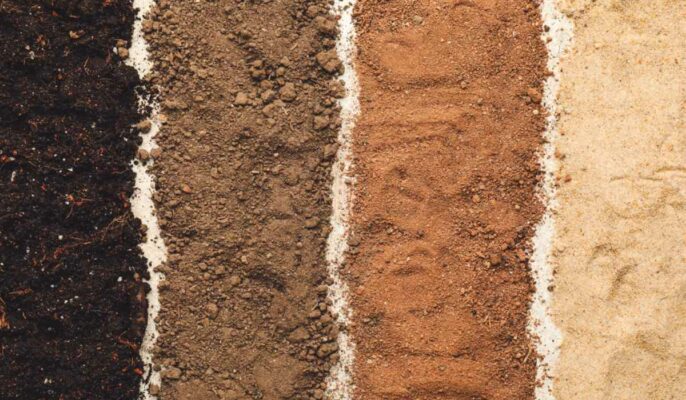Soil, the essential foundation for life, is the Earth’s crust’s upper layer that sustains plants. It’s a complex mixture of minerals, organic matter, water and air. So, understanding soil types and their impact on crop growth is crucial for successful agriculture. This article will explore soil types, their formation, composition and uses while shedding light on the crops each soil type supports.
Source: Pinterest (Gardening Know How)
See also: 5 tips to maintain soil health
What is soil?
Soil, often called Earth’s skin, results from intricate interactions between geological, climatic and biological forces. It encompasses particles, humus, water and living organisms. Its formation is influenced by factors such as parent material, climate and time. Soil serves as a growth medium for plants, modifies the atmosphere and provides habitats for organisms.
Composition of soil
Source: Pinterest (Gardener’s Path)
Soil is a heterogeneous mixture containing:
- Organic matter: Sourced from plants and animals, organic matter is pivotal in soil fertility.
- Minerals: These solid elements, with a fixed chemical composition, form the soil mineral fraction.
- Gaseous components: Air-filled pores house gases like nitrogen, oxygen and carbon dioxide, which are vital for plant and microbial respiration.
- Water: It helps dissolve minerals and nutrients and transports essential elements for plant growth.
How is soil formed?
Soil formation occurs through rocks’ physical, chemical and biological weathering.
- Physical weathering: Mechanical forces like wind, water and temperature break rocks into smaller particles.
- Chemical weathering: Chemical reactions alter rock composition, affecting soil chemistry.
- Biological weathering: Living organisms like plants and microorganisms accelerate rock disintegration, enhancing soil development.
Soil profile and its significance
Source: Pinterest (nesoil.com)
The soil profile, consisting of different layers or horizons, offers insights into soil characteristics. The topsoil (Horizon A) is rich in organic matter, essential for plant growth. Subsoil (Horizon B) contains minerals and less humus. Horizon C is the weathered rock layer. Understanding soil profiles aids in selecting suitable crops and implementing effective soil management practices.
Classification of soil
In ancient India, the soil was classified based on its fertility – Urvara (fertile) and Usara (sterile). Today, we employ more detailed classifications, including alluvial, black cotton, red anf yellow, laterite, mountainous, arid, saline and alkaline, and peaty and marshy soils. Each type presents unique characteristics and challenges for cultivation.
Different soil types and their characteristics
Soil classification primarily depends on its composition, texture and properties. These types play a pivotal role in determining the crops that grow within them:
Alluvial soil
- Covers 40% of India’s land area, primarily in northern plains and river valleys.
- Rich in potash, poor in phosphorus.
- Supports crops like wheat, maize, sugarcane and oilseeds.
Black cotton soil
Source: Pinterest
- Occupies 15% of India’s land, prominent in the Deccan Plateau.
- Clayey; swellable when wet.
- Cultivates cotton, pulses, millets and tobacco.
Red and yellow soil
- Encompasses 18.5% of India’s land, found in low-rainfall regions.
- Rich in iron and aluminium; poor in nitrogen and phosphorus.
- Cultivates oilseeds, millets, tobacco and pulses.
Source: Pinterest (Lashika Arora)
Laterite soil
- Covers 3.7% of India’s land, prevalent in monsoon climates.
- Deficient in organic matter, nitrogen and phosphate.
- Suitable for cashew nuts, rice and sugarcane.
Mountain soil
Source: Pinterest (Leingamla A Chihui)
- Thrives in forested regions with adequate rainfall.
- Variable texture, fostering diverse vegetation.
- Fertile in valleys, acidic with low humus on higher slopes.
Desert soil
- Found in arid and semi-arid areas, covering 4.42% of India’s land.
- Saline; poor in nutrients.
- Supports salt-resistant crops under improved irrigation.
Source: Pinterest
Peaty/Marshy soil
- Flourishes in high rainfall and humidity regions.
- Rich in organic matter, alkaline.
- Found in Uttarakhand, Bihar and coastal areas of West Bengal.
- Cultivates blueberries, brassicas, legumes, peppers and tomatoes.
Saline and alkaline soil
- Infertile due to high salt content.
- Found in arid and semi-arid areas, delta regions.
- Reclamation is possible through drainage, gypsum and salt-resistant crops.
Clay soil
Source: Pinterest (Jojo)
- Characterised by its fine texture and water-retention capabilities, clay soil is suitable for crops like rice, which require consistent moisture levels.
- However, proper drainage and soil management are essential to prevent waterlogging.
Sandy soil
Source: Pinterest (Family Handyman)
- With its coarse texture and fast drainage, sandy soil suits drought-resistant crops such as cacti and certain cereals like maize and barley.
- Regular irrigation is crucial due to its water-permeable nature.
Loamy soil
- Loamy soil balances water retention and drainage, making it a preferred choice for many crops.
- Crops like wheat, cotton and sugarcane flourish in this adaptable soil type.
Silt Soil
- Silt soil, with its fine particles, offers a middle ground between clay and sandy soils.
- It supports crops like pulses, oilseeds and vegetables by retaining suitable moisture and drainage.
FAQs
How is soil formed?
Soil is formed through mechanical, chemical and biological weathering of rocks, influenced by factors like climate, vegetation and time.
What are the primary factors influencing soil formation?
Soil formation is influenced by parent material, climate, vegetation, relief, time and various biological processes.
Why is loamy soil considered ideal for plant cultivation?
Loamy soil balances different soil types, offering adequate moisture retention, good drainage and essential nutrients for plant growth.
What is the significance of soil?
Soil supports plant growth, sustains life forms and provides valuable resources.
Which soil type is best for cotton cultivation?
Black cotton soil, also known as Regur soil, is ideal for cotton cultivation due to its unique properties.
| Got any questions or point of view on our article? We would love to hear from you. Write to our Editor-in-Chief Jhumur Ghosh at jhumur.ghosh1@housing.com |
